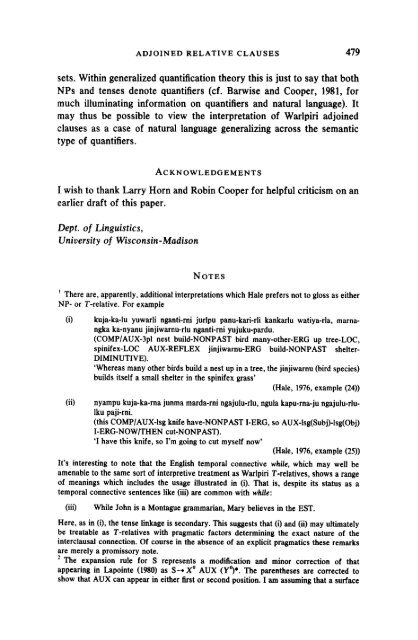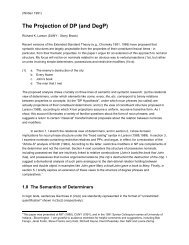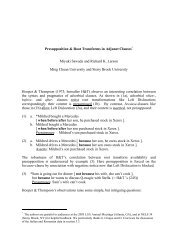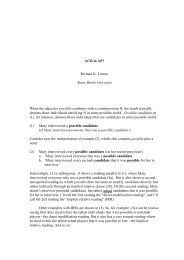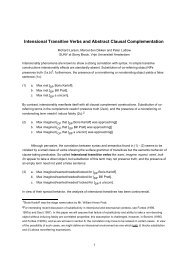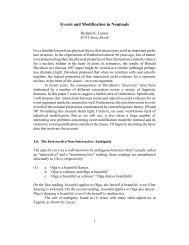A note on the interpretation of adjoined relative clauses
A note on the interpretation of adjoined relative clauses
A note on the interpretation of adjoined relative clauses
You also want an ePaper? Increase the reach of your titles
YUMPU automatically turns print PDFs into web optimized ePapers that Google loves.
ADJOINED RELATIVE CLAUSES 479<br />
sets. Within generalized quantificati<strong>on</strong> <strong>the</strong>ory this is just to say that both<br />
NPs and tenses de<str<strong>on</strong>g>note</str<strong>on</strong>g> quantifiers (cf. Barwise and Cooper, 1981, for<br />
much illuminating informati<strong>on</strong> <strong>on</strong> quantifiers and natural language). It<br />
may thus be possible to view <strong>the</strong> interpretati<strong>on</strong> <strong>of</strong> Warlpiri <strong>adjoined</strong><br />
<strong>clauses</strong> as a case <strong>of</strong> natural language generalizing across <strong>the</strong> semantic<br />
type <strong>of</strong> quantifiers.<br />
ACKNOWLEDGEMENTS<br />
I wish to thank Larry Horn and Robin Cooper for helpful criticism <strong>on</strong> an<br />
earlier draft <strong>of</strong> this paper.<br />
Dept. <strong>of</strong> Linguistics,<br />
University <strong>of</strong> Wisc<strong>on</strong>sin-Madis<strong>on</strong><br />
NOTES<br />
i There are, apparently, additi<strong>on</strong>al interpretati<strong>on</strong>s which Hale prefers not to gloss as ei<strong>the</strong>r<br />
NP- or T-<strong>relative</strong>. For example<br />
(i)<br />
(ii)<br />
kuja-ka-lu yuwarli nganti-rni jurlpu panu-kari-rli kankarlu watiya-fla, marnangka<br />
ka-nyanu jinjiwarnu-flu nganti-rni yujuku-pardu.<br />
(COMP/AUX-Bpl nest build-NONPAST bird many-o<strong>the</strong>r-ERG up tree-LOC,<br />
spinifex-LOC AUX-REFLEX jinjiwarnu-ERG build-NONPAST shelter-<br />
DIMINUTIVE).<br />
'Whereas many o<strong>the</strong>r birds build a nest up in a tree, <strong>the</strong> jinjiwarnu (bird species)<br />
builds itself a small shelter in <strong>the</strong> spinifex grass'<br />
(Hale, 1976, example (24))<br />
nyampu kuja-ka-rna junma marda-rni ngajulu-rlu, ngula kapu-rna-ju ngajulu-rlulku<br />
paji-rni.<br />
(this COMP/AUX-lsg knife have-NONPAST I-ERG, so AUX-lsg(Subj)-lsg(Obj)<br />
I-ERG-NOW/THEN cut-NONPAST).<br />
'I have this knife, so I'm going to cut myself now'<br />
(Hale, 1976, example (25))<br />
It's interesting to <str<strong>on</strong>g>note</str<strong>on</strong>g> that <strong>the</strong> English temporal c<strong>on</strong>nective while, which may well be<br />
amenable to <strong>the</strong> same sort <strong>of</strong> interpretive treatment as Warlpiri T-<strong>relative</strong>s, shows a range<br />
<strong>of</strong> meanings which includes <strong>the</strong> usage illustrated in (i). That is, despite its status as a<br />
temporal c<strong>on</strong>nective sentences like (iii) are comm<strong>on</strong> with while:<br />
(iii)<br />
While John is a M<strong>on</strong>tague grammarian, Mary believes in <strong>the</strong> EST.<br />
Here, as in (i), <strong>the</strong> tense linkage is sec<strong>on</strong>dary. This suggests that (i) and (ii) may ultimately<br />
be treatable as T-<strong>relative</strong>s with pragmatic factors determining <strong>the</strong> exact nature <strong>of</strong> <strong>the</strong><br />
interclausal c<strong>on</strong>necti<strong>on</strong>. Of course in <strong>the</strong> absence <strong>of</strong> an explicit pragmatics <strong>the</strong>se remarks<br />
are merely a promissory <str<strong>on</strong>g>note</str<strong>on</strong>g>.<br />
2 The expansi<strong>on</strong> rule for S represents a modificati<strong>on</strong> and minor correcti<strong>on</strong> <strong>of</strong> that<br />
appearing in Lapointe (1980) as S--* X ° AUX (yO),. The paren<strong>the</strong>ses are corrected to<br />
show that AUX can appear in ei<strong>the</strong>r first or sec<strong>on</strong>d positi<strong>on</strong>. I am assuming that a surface


